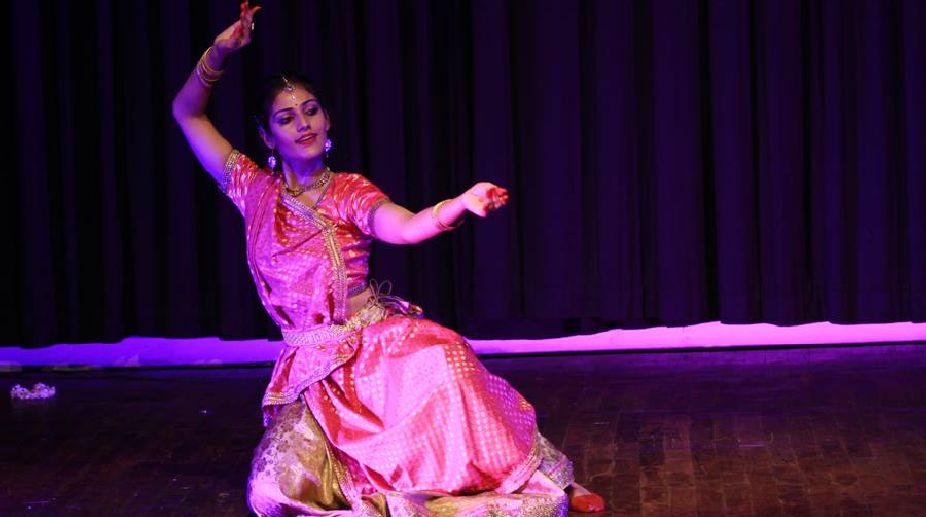Guinness World Record of ‘Classical Dance Relay Marathon’ in MP
Officials of the Guinness Records handed over the certificate of the world record to Madhya Pradesh Chief Minister Dr Mohan Yadav at the festival on Thursday evening.

(Photo: Facebook)
Our classical dance forms are intrinsically a powerful language of expression and communication.
The week gone by saw Sanchita Abrol, a young Kathak dancer and Gopika Varma, the renowned Mohiniyattam exponent, interpreting stories through their specific dance forms with absolute power and extreme sensitivity. Sanchita Abrol, the gifted disciple of Guru Shovna Narayan, presented Ghar ~ Prem ki Gaagar, based on a Dogri poem Ghar, by the renowned Dogri poet, author and Sahitya Akademi Awardee, late Group Captain Randhir Singh, popularly known as "Kunvar Viyogi" in the literary circles.
Advertisement
The Kathak presentation at the of Kingdom of Dreams, Gurgaon, equipped with world class theatre facilities, left its awe-inspiring impact from the very beginning, when the danseuse emerged on the stage from within, with the pictorial backdrop of home, the "Ghar", in the natural surroundings of greenery and trees blooming with flowers.
Advertisement
The magnificent backdrop kept changing according to the content and context of the poetry.
The theme of Love, with its interconnected physical and emotional aspects, was skillfully interpreted through the language of Kathak, where the intrinsic nature of love was portrayed through Kavittas, Tode, Tukde, Paran and Chakradar Tihais and Gat-Nikas, the traditional repertoire of Kathak, interspersed with the Dogri poem underlining the spiritual aspect embodied in the imagery of courage and sacrifice with the allegory of the insect that roams around the flame, knowing well that he would get burnt to ashes: "Jal Parwana mitti banata/Mitti se phir Deep. Isee vidhi se Deepak jalate hain ghar-ghar…".
The scintillating Tarana in Bageshri with the pathos of the poignant raga reiterated how the "heart always finds its home in love".
The music composed by Madho Prasad recapitulated "Love's philosophy", a poem by the classical English romantic poet Shelley.
The role of Sutradhar, performed by Ayushman Jamwal, could have worked better just as an introductory element. The impressive production was conceptualised, choreographed and directed by Sanchita in collaboration with the Kunvar Viyogi Memorial Trust, that aims at promoting young talents from the field of art.
This was Sanchita's second venture with the Dogri poetry after "Uttar Behini", a Dogri dance production was preceded by a documentary on the history and significance of river Devika in Indian mythology and Dogri literature; conceptualised, researched and directed by Sanchita herself.
Both the productions had meticulous inputs of music by Madho Prasad and costumes by designer Seerat Narindra.
* * *
Shapatham-Shapam in Mohiniyattam
The Kalaimamani and Kalashree awardee Mohiniyattam exponent Gopika Varma has reason to be the enchantress she is. She was initiated into Mohiniyattam at the age of 10 by her grandmother Vanaja Nair and was trained under Girija and Chandrika Kurup, both senior disciples of Kalyani Kutti Amma. Gopika was fortunate to learn Abhinaya from Kalamandalam Krishnan Nair and was fur ther groomed in Sopanam style under Kavalam Narayan Panikkar.
Gopika mesmerised the audience at the IIC auditor ium at the Bicentenary of Royal Rescript, Travancore, celebrated by the Institute of Social Sciences, Kerala.
Opening her recital with Chitranga, the conventional invocation to Ganapati, she presented "Shapatham- Shapam", written and composed by Kavalam Narayan Pannikar.
The powerful performance depicted the agony of two powerful women from the epic Mahabharata: "Shapatham", or pledge, of Draupadi and the "Shapam", or curse of Gandhari, the first one about the war of Kurukshetra and the other, its after effect. Draupadi, after the fulfilment of her Shapatham of smearing her hair with Duryodhana's blood, asks Krishna whether it was her victory or failure?
She remembers the entire story of how the worthy daughter of King Dhrupad was forced to become the "Charanadasi" servant of five husbands without asking her willingness; the unfortunate incident that caused the war when she laughed at Duryodhan tripping on water and antagonised him; how she was disrobed in the cour t of Kauravas when none of her five husbands came to her rescue before Krishna saved her.
Shapam was the tragic story of Gandhari, who was taken for a ride by Bhishma, to marry the blind king Dhritarashtra, how she got 100 sons, none of whom survived to perform her last rights. She curses Krishna to get a death like hers. Gopika's intense Abhinaya as both Draupadi and Gandhari, was intense and powerful.
The imaginativelycomposed music, using the base of Ragas like Sankarabharanam, Dwijawanti and Shivaranjani or the use of just the Tanpura or the percussions, evoked emotions that enhanced the mesmerising performance concluding with the poignant pathos of raga Revathi.
Advertisement
Officials of the Guinness Records handed over the certificate of the world record to Madhya Pradesh Chief Minister Dr Mohan Yadav at the festival on Thursday evening.
The capital city witnessed an enchanting evening of classical dance at Samasrava, organised by Manasija, a non-profit dedicated to promoting Indian art and culture, recently.
A visit to Natavari Academy’s celebration of the 85th birth anniversary of Guru Purushottam, popularly known as Puru-Dadheech in Indore, on the 17th and 18th of July 2024 was the experience of a lifetime.
Advertisement
